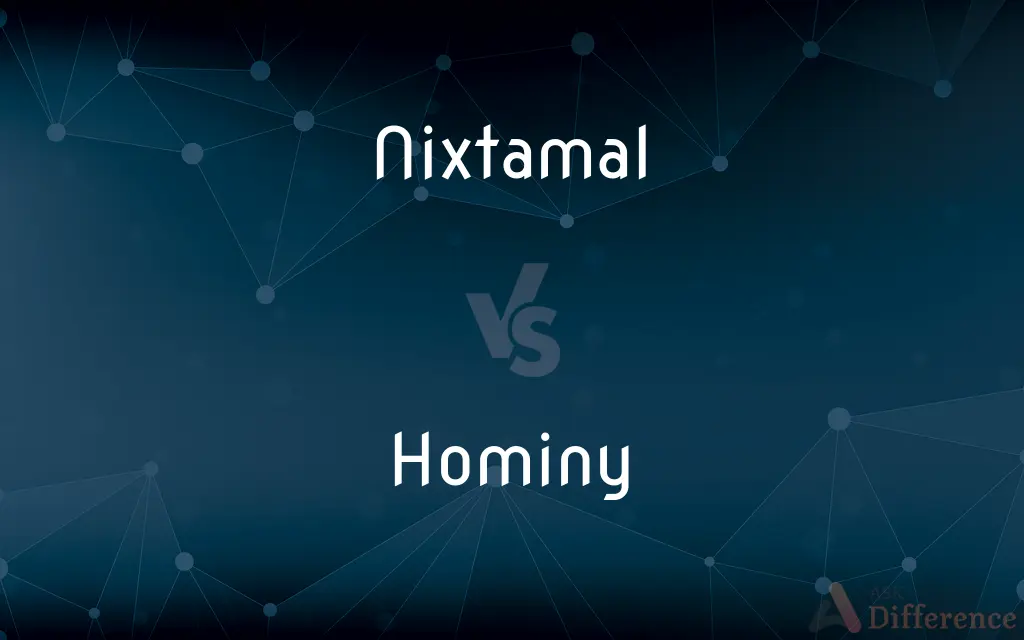Nixtamal vs. Hominy — What's the Difference?
By Urooj Arif & Fiza Rafique — Updated on March 15, 2024
Nixtamal and hominy both refer to corn that has undergone a process involving an alkaline solution, but they differ in their cultural origins and specific uses.

Difference Between Nixtamal and Hominy
Table of Contents
ADVERTISEMENT
Key Differences
Nixtamal, a term derived from Nahuatl, the language of the Aztecs, refers to corn that has been soaked and cooked in an alkaline solution, typically limewater, and then hulled. This process, known as nixtamalization, significantly enhances the nutritional value of corn, making niacin (Vitamin B3) available for absorption, and improving the amino acid profile of the proteins in corn. Hominy, often associated with Southern and Native American cuisines in the United States, also involves corn that has been treated with an alkaline solution. However, hominy typically refers to the whole kernels that have been nixtamalized, which can be used whole, ground, or mashed in various dishes.
Nixtamal is a foundational ingredient in traditional Mexican and Central American cuisines, used to make masa, the dough that forms the basis for tortillas, tamales, and other staple dishes. Hominy is known for its role in foods like hominy grits, where the kernels are ground coarsely, and in traditional dishes like posole, a hearty stew.
While both nixtamal and hominy undergo a similar chemical process, the term "nixtamal" is more closely associated with the process itself and its resulting product, particularly in the context of masa preparation. In contrast, "hominy" refers more specifically to the treated kernels and their use in certain culinary traditions, particularly within the United States.
The primary difference lies in their cultural and culinary contexts: nixtamal is central to Mesoamerican cuisine and its traditional dishes, while hominy plays a significant role in the culinary traditions of the Southern United States and Native American communities. Despite these differences, both nixtamal and hominy highlight the importance and versatility of corn in the Americas and the ingenuity of its original cultivators and consumers.
Comparison Chart
Origin
Mesoamerican (e.g., Mexican, Central American)
Southern and Native American cuisines in the U.S.
ADVERTISEMENT
Definition
Corn treated with an alkaline solution, used to make masa
Whole kernels of corn treated with an alkaline solution
Culinary Uses
Basis for masa, tortillas, tamales
Used whole, ground (e.g., grits), or in stews (e.g., posole)
Cultural Significance
Integral to traditional Mexican and Central American dishes
Important in Southern U.S. and Native American cuisines
Terminology
Derived from Nahuatl, reflecting indigenous Mesoamerican heritage
English term, adapted from Algonquian languages
Compare with Definitions
Nixtamal
The process improves the nutritional profile of corn, making it a dietary staple.
Nixtamal is essential for making authentic Mexican tamales.
Hominy
Nixtamalized corn kernels used in various Southern and Native American dishes.
Hominy grits are a staple breakfast item in the Southern U.S.
Nixtamal
Integral to traditional Mesoamerican cuisine, forming the basis for many staple dishes.
Nixtamalization was a crucial discovery for ancient Mesoamerican civilizations.
Hominy
Represents the adaptation of indigenous food practices by European settlers and African slaves.
The use of hominy in Southern cuisine reflects a blend of cultural culinary traditions.
Nixtamal
Corn treated with an alkaline solution to enhance nutritional value, used in making masa.
Masa for tortillas is made from ground nixtamal.
Hominy
Can be eaten whole or ground into grits, showcasing its versatility.
Hominy is a key ingredient in traditional posole stew.
Nixtamal
Reflects the deep culinary traditions of indigenous cultures in Mexico and Central America.
The technique of making nixtamal has been passed down through generations.
Hominy
Its preparation and consumption connect modern cuisines with Native American heritage.
Hominy has been consumed for centuries, dating back to early Native American diets.
Nixtamal
Used in a variety of dishes beyond tortillas, such as tamales and arepas.
Nixtamal dough is versatile in Mesoamerican cooking.
Hominy
Available canned or dried, it's accessible for various culinary uses.
Canned hominy can be used for a quick addition to soups and stews.
Nixtamal
In Latin American cookery: maize kernels which have been boiled and steeped in an alkaline solution (usually lime water) in order to remove the hulls, used to make masa.
Hominy
Hominy is a food produced from dried maize (corn) kernels that have been treated with an alkali, in a process called nixtamalization (nextamalli is the Nahuatl word for "hominy"). "Lye hominy" is a type of hominy made with lye.
Nixtamal
Hominy; maize kernels which have undergone nixtamalization, that is, hulling and soaking and cooking in an alkaline solution.
Hominy
Coarsely ground corn (maize) used to make grits
Hominy grits
Hominy
Whole or ground kernels of corn from which the hull and germ have been removed, as by boiling in a solution of water and lye.
Hominy
A food made from hulled corn (maize) kernels soaked in lye water, rinsed, then cooked and eaten; or, the rinsed kernels are dried and coarsely ground into hominy grits.
Hominy
Maize hulled and broken, and prepared for food by being boiled in water.
Hominy
Hulled corn with the bran and germ removed
Common Curiosities
How do cultural contexts influence the use of nixtamal and hominy?
Nixtamal is central to Mexican and Central American cuisines, while hominy is significant in Southern U.S. and Native American foods.
What is the primary difference between nixtamal and hominy?
Nixtamal refers to the process and product used in masa, while hominy refers to whole kernels used in various dishes.
Is nixtamalization unique to Mexican cuisine?
While it originated in Mesoamerica, the process and its products, like hominy, are used in various cuisines.
Are nixtamal and hominy nutritionally beneficial?
Yes, both undergo nixtamalization, which enhances the nutritional value of corn.
How is hominy produced?
Hominy is produced by soaking maize kernels in a lye or lime solution to remove the hull and germ, resulting in a softer, puffed grain.
Are nixtamal and hominy the same thing?
While both involve processed corn, nixtamal refers more specifically to the treated corn kernels before they are ground, and hominy generally refers to the whole, treated kernels often used in various cuisines.
Can hominy be made from any type of corn?
Yes, but it is typically made from dent corn, which has a softer starch and is more easily treated and hulled than other types.
Can nixtamal be used to make masa?
Yes, nixtamal is ground to make masa, a dough used for making tortillas, tamales, and other Latin American dishes.
Is hominy only used in savory dishes?
Primarily, yes. Hominy is often used in savory dishes like soups, stews, and hominy grits, but it can occasionally be incorporated into other recipes.
How does the taste of nixtamal differ from hominy?
Nixtamal, when ground into masa, has a distinct, slightly earthy and lime flavor, while hominy has a milder taste, retaining more of the corn's natural sweetness.
Where did the process of nixtamalization originate?
The process originated in Mesoamerica, with evidence dating back to around 1500–1200 BCE among ancient civilizations like the Aztecs and Mayans.
Can nixtamal be used to make grits like hominy?
Technically, both can be ground for different types of dough or meal, but traditional grits are more associated with hominy.
What is nixtamalization?
Nixtamalization is a process involving the soaking and cooking of corn in an alkaline solution, usually limewater, which improves its nutritional value, flavor, and texture.
What are the nutritional benefits of nixtamalization?
Nixtamalization enhances the nutritional profile of corn by increasing its calcium content, making niacin more available, and improving protein quality.
How long does the nixtamalization process take?
The process can take anywhere from several hours to overnight, depending on the intended use of the nixtamal and traditional practices.
Share Your Discovery

Previous Comparison
Company vs. Organization
Next Comparison
Inquiry vs. ResearchAuthor Spotlight
Written by
Urooj ArifUrooj is a skilled content writer at Ask Difference, known for her exceptional ability to simplify complex topics into engaging and informative content. With a passion for research and a flair for clear, concise writing, she consistently delivers articles that resonate with our diverse audience.
Co-written by
Fiza RafiqueFiza Rafique is a skilled content writer at AskDifference.com, where she meticulously refines and enhances written pieces. Drawing from her vast editorial expertise, Fiza ensures clarity, accuracy, and precision in every article. Passionate about language, she continually seeks to elevate the quality of content for readers worldwide.














































